The Redhead from Wyoming (1953) / Pillars of the Sky (1956)/ Gun for a Coward (1957)
BLU-RAY STREET DATE: APRIL 6, 2021/KL STUDIO CLASSICS
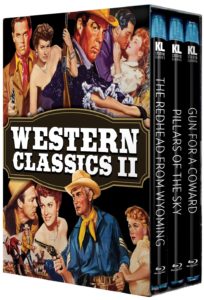
“There’s a rich, distinctive look to Universal’s Westerns of the 1950s. They’re bright, full of action, and usually look like a million bucks- no matter what they actually cost.”
Those are the recent words of film historian Toby Roan, spoken on his audio commentary track of the film Pillars of the Sky. Pillars of the Sky is one of three such Universal Westerns of the 1950s gathered by Kino Lorber Studio Classics for the recent box set, “Western Classics II”. It’s a fine set reflective of the genre’s greatest era; one that any fan will not want to miss.
The set is, of course, a follow-up to the June 2020 set, “Western Classics I“. That set brought us a trio of terrific 1940s Universal Westerns and stands as one of KL’s absolute finest releases in its current run of themed three-disc Blu-ray box sets. While this fresh follow-up doesn’t quite hit on all cylinders the way that that one does, it is nonetheless worthy.
Spanning from 1953 to 1957, the three films in this set have almost nothing in common outside of their genre, studio and time of production. The Redhead from Wyoming stars Maureen O’Hara as a “fancy lady” with a complicated past who heads up a “club” in a nowhere town; Pillars of the Sky is a midrange U.S. Cavalry thriller with a conscious, and Gun for a Coward is a drama of three very different brothers as they manage their expanding cattle business. Read on for individual reviews and a few parting thoughts…
The Redhead from Wyoming
DIRECTED BY LEE SHOLEM/1953
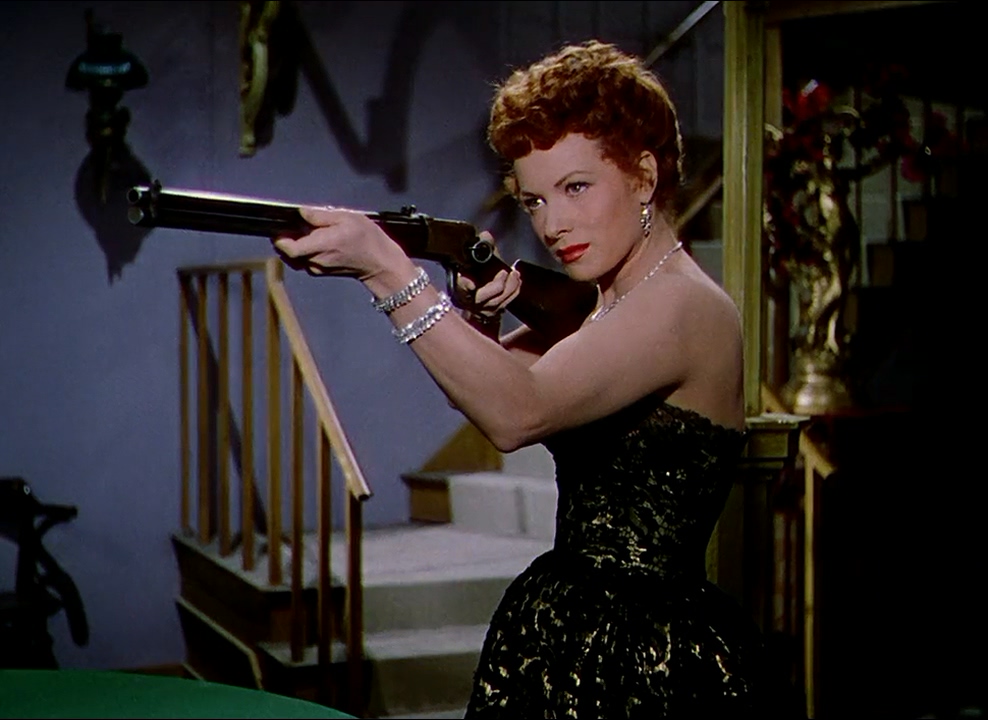
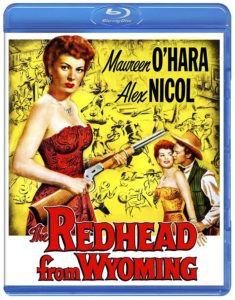
A black sequined strapless number may not be ideal attire for a town-wide shootout, but don’t tell that to the great Maureen O’Hara. O’Hara, the only woman who could consistently go toe to toe with John Wayne, takes center stage in 1953’s The Redhead from Wyoming. As the opportunizing Kate Maxwell, she dominates this character-heavy action/drama, and rightly stands as the best thing about.
As directed by Lee Sholem in vivid, popping Technicolor, The Redhead from Wyoming is not a bad film nor a particularly petty one. If anything, its plot is too knotty, too convoluted. The minute that Kate steps into town she immediately finds herself caught up in a criminal scheme involving illegitimate branding irons and cattle rustling. In 1870 Wyoming, these offenses are no joke- consequences, we’re told, are worse than jail.
This isn’t what she was bargaining for, having been lured to town to head up a rousing new saloon with her name on it. Alas, she covers for the corrupt would-be governor (William Bishop) who, it turns out, is doing all of this to trigger a full-on range war. All the while, the town’s strangely dour sheriff (Alex Nicol) finds himself caught in the middle.
For all its action and wealth of characters who do indeed get to doing a lot of shooting at one another, the greatest pleasure of The Redhead from Wyoming is its fiery star. O’Hara gets to play a wide array of diverse notes, often within seconds of one another. Don’t let the saloon piano veneer of certain notes fool you when she’s in charmer mode- this is a solid character who knows her stuff and can only be a pawn for so long.
Film historian Samm Deighan has a very good audio commentary that isn’t afraid to flag some of the obviously sidestepped aspects of what really would be going on in the film. O’Hara’s character, she points out, was modeled on a real-life woman who, among other things, did in fact have a history of prostitution. She says what most anyone watching The Redhead from Wyoming would be thinking but is never acknowledged on screen, that a strong willed and enterprising woman like Maxwell wouldn’t agree to relocate herself and several showgirls to the middle of nowhere to simply run a club. This is no mere redhead fresh off the coach- this is a heat-packin’ madam!
Pillars of the Sky
DIRECTED BY GEORGE MARSHALL/1956

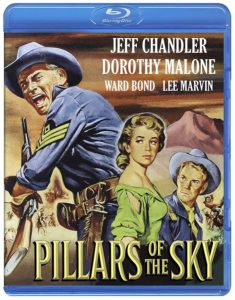
By 1956, leading man Jeff Chandler was riding high at Universal. With his steely blue eyes and imposing tombstone-grey demeanor, the actor could fuse nobility and menace like no other. For the first half of director George Marshall’s midrange Western Pillars of the Sky, it’s effectively impossible to pin down the moral centering of Chandler’s character.
He plays First Sgt. Emmett Bell of the U.S. Cavalry, a man loyal to his flag but also a friend of the bottle. Bell has enlisted a number of Native Americans as scouts for his battalion, all of whom have converted to Christianity, going as far as adopting Biblical names. Their faith is shepherded by Dr. Joseph Holden, played by Western icon Ward Bond. Holden pulls double duty, acting as both pastor and field doctor during the battles with the not-so-friendly native factions.
Which raises that old representational rub with classic Westerns… Pillars of the Sky, by mainstream 1956 standards and values, is in fact rather progressive in terms of its depiction of Indian characters. Several demonstrate bona fide human complexity and deep conflict within the people group, nullifying the notions of “the noble savage” or the “scalp hunter”. Yes, the Christian converts in Cavalry uniforms get the sympathetic edge, and ultimately the film gets to have it both ways, scoring points for deeper-than-previous representation, and propping up plenty of “really bad” Indians to shoot. And of course, there’s no shortage of white actors in “redface”. Pillars in the Sky is far from alone in its issues in this department, all of which, going forward, are not going to be perceived as any less problematic.
But the more overarching problem with Pillars of the Sky is simply that it fails to fully engage the audience. Cavalry Westerns are tougher sell these days in a genre that’s become a tougher sell altogether- and perhaps that reality is particularly apparent here. Indirectly dealing with what the U.S. Cavalry is often associated with- the tragic, horrific injustices inflicted upon the American Indians- can only bear so much handwringing revisionism on the part of white Hollywood. The U.S. Cavalry for many can be an uncomfortable thing in and of itself. Pillars of the Sky, based on the novel Frontier Fury by Heck Allen, does very little to divert from that. Part of it might be that despite his showstopping action set pieces, George Marshall is a director more aptly gifted for comedy (Murder, He Said; The Ghost Breakers) than complex historical Western drama.
The transfer of Pillars of the Sky strikes one as merely “pretty good”. Despite some vibrant color cinematography and still looking okay, there’s an “old broadcast television” texture about it. Film Historian Toby Roan has an optional audio commentary that is far from wall-to-wall, but not short on detail. The fits-and-starts editing approach of Roan’s track is something different, but actually helps the interested viewer take in the information. It’s a good move.
Gun for a Coward
DIRECTED BY ABNER BIBERMAN/1957
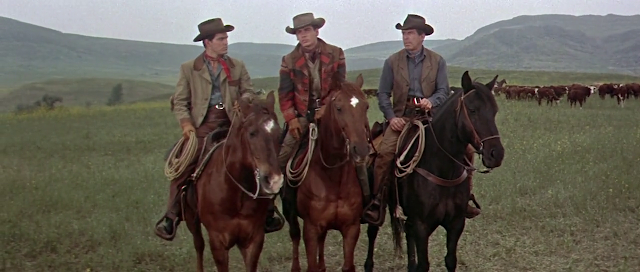
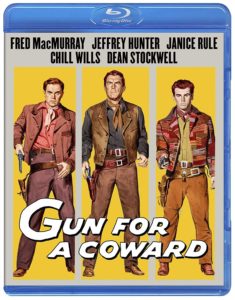
For an actor who only directed less than ten movies, Abner Biberman’s Gun for a Coward is a very admirable accomplishment. Loose in plot but tight with story, the film tells the story of the three Keough brothers as they navigate their bustling cattle ranch. The brothers are as mismatched in temperament as they are in apparent age. Fred MacMurray is Will, the oldest and most levelheaded. Since the early death of their father a while ago, Will’s assumed the role of sturdy patriarch, one that suits him well enough. (It helps to have MacMurray in this part, though on the negative side, the forty-eight-year-old actor can’t help but read as twice the age of his character’s brothers).
The middle brother, Bless (Jeffrey Hunter), has grown up racked with guilt from his presence at their father’s sudden death, a rattlesnake that he failed to subdue. But then again, Bless was only a young child then. Since then, his pacifist streak has only persevered, though it hasn’t evolved. In the American West, there’s little room for such sensibility. That fact is continually made clear by the youngest brother, Hade, a hothead youth living a good century ahead of the post-James Dean teenager culture that his portrayer, Dean Stockwell, was hailing from when Gun for a Coward was released in 1957.
Today, Hade’s tight-fisted selfishness resembles the kind of close-handed xenophobic extreme political conservatism that’s become an epidemic in America and elsewhere. When three Native Americans (led by Iron Eyes Cody) arrive looking for twenty heads of cattle, Will and Bless understand that things have been rough for the Indians since the buffalo were decimated. “Give ‘em nothin’!”, Hade repeatedly insists, recklessly threatening peace in the process. Will smooths things over and strikes a reasonable middle ground, offering six heads. It’s a deal. As far as Hade’s concerned, they might as well have just handed over their whole ranch.
Gun for a Coward, despite its goofy and condemning title, sympathizes deeply with Bless. This perspective places Gun for a Coward on the progressive end of 1950s Westerns, a position not nearly as rare as the genre’s reputation would have us believe, but still infrequent enough to be refreshing. Without being an out-and-out “psychological Western” in way that the Anthony Mann/James Stewart film of the time were, it is nonetheless part of a budding national reevaluation of the country’s past. The full-on revisionist Westerns by the likes of Sam Peckinpah and Arthur Penn were a good decade away, but humble films such as this one paved the way. In so doing, Biberman demonstrates a committed sensitivity in directing his actors. Each and every performance is allowed to breathe and exist on its own terms, though the film’s obligatory excitement and pace are never sacrificed.
The core of Gun for a Coward, however, is not, as the title implies, Bless’s need to finally “man up” and shoot someone, but an awkward love triangle between Will and Bless as they both pursue the lovely but soul tortured Aud (a wonderful performance by Janice Rule). The quippy and hard-riding Aud is no mere prize for the guys to win, though she does go from pants to dresses in the course of the film. Will’s been promised Aud by her father and has gone about courting her for the previous four years. But her heart has always been with Bless, even as he’d yet to come into his own. It’s a tangled and somewhat uncomfortable web, but it’s also just the kind of soap opera that allows Gun for a Coward to stand out today.
Film Historian Lee Gambin contributes an info-packed, tightly organized audio commentary track to the disc. The film’s transfer is not the greatest, as its Eastman Color processing is showing signs of minor color misalignment, often resulting in that lightly “muddy” look also afflicting Pillars of the Sky. Gun for a Coward is worthy of a more dedicated restoration. Here’s hoping that one day it might get one.
*****
While none of the three films collected for this set are duds, only Gun for a Coward stands out as a must-own for any Western fan. That said, The Redhead from Wyoming and Pillars of the Sky are easily welcome additions to any such shelf.
While Toby Roan is right that these Universal International Westerns are bright and full of action, this set is also an unfortunate reminder that all Blu-rays are not created equal. It is in fact the not-fully-there intended vibrancy of these films that betray the lack of needed 2K and 4K restorations. But then again, one is not inclined to complain too loudly, as financial realities no doubt dictate the level of care that such lesser-known niche films such as these are able to be given. These Kino Lorber Studio Classics three-disc Blu-ray sets are often available at a considerably lower price point than the titles would be if sold individually. The mere fact that films such as these have been given the Blu-ray upgrade is nothing to dismiss. Even still, the inclusions of this mismatched three-movie roundup are better now than they ever have been on home video.

